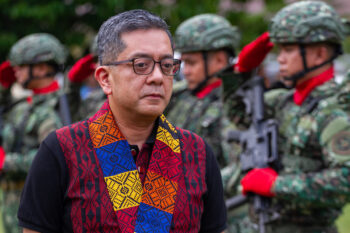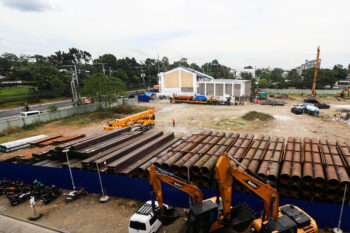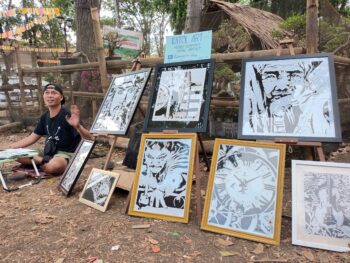QUEZON CITY (MindaNews / 27 July) — When we emphasized the role of revelations as furqan or criterion of right and wrong and that they reflect in manifold ways in history, our end is to highlight the universality of revelations and the role of prophets in each historical period.
Yet, as we said, there is a qualitative difference between the revelations and prophets before and after Prophet Muhammad (SAW). Before, prophets and their teachings were active players in society given the immensity of their teachings, personalities, miracles, and so on. Somehow, if the Holy Qur’an is a mirror, then all the teachings of prophets are made to reflect the teachings of the Holy Qur’an, as if eon of history where all revelations and prophethood had been transformed into a miniscule and made part of the Holy Qur’an. That is why, we said, the birth of Prophet Muhammad (SAW) including the sending of revelation (wahy) and its finalization in the Holy Qur’an was a landmark in history.
Yet, we also said, after Prophet Muhammad (SAW) with no new prophets around and no new revelation sent to mediate history similar to the intensity during the time of prophets before Prophet Muhammad (SAW), the same mirror of the Holy Qur’an actually exists. But there is also a qualitative difference as far as its reflection is concerned; that is, history seems to be made neutral where mankind is given a choice or freewill to understand themselves, the world, creation and so on and so forth, without actual intervention in their lives from prophets.
When, in our previous khutbah (discourse), we tried to delineate two lines of history, as we tried to highlight how “nature” has been taken as a frame in understanding creation, we say that, the same is true actually in the early formation of Islamic thought. There was strong interest in understanding the ayah (signs) of creation, which later on, was termed “nature” in the West. The ayah in creation, as we said, is subject of immense interest in the Holy Qur’an. In fact, it is mentioned several times like the famous verse: “Behold! in the creation of the heavens and the earth and the alternation of Night and Day, – There are indeed signs (ayah) for men of understanding (Al-imran: 190).”
Ayah and nature
Thus, we said, the study of ayah has been intrinsic into the frame or core of Islamic thought. This has been the trajectory since the time of the Prophet (SAW) well until around 12th century with two intellectual giants – Imamu l-ghazali and Ibn Rushd – hurdling the question in understanding the world and nature.
At certain point, however, there was a lull of interest in the Muslim world leaving around a gap of three hundred years when the West started to get interested in science with the birth of Enligthenment and Renaissance, which included incidentally the contribution of the works of Ibn Rushd and others. Since then, Western Science grew unhindered producing marvels with their attendant effects of threats and hazards to mankind that eventually characterized as progress in Western civilization.
Whereas the Muslim world remained hurdling with knowledge and what direction she would go. There are many views about it. To mention few contemporary ones: some thinkers argue on the nature of knowledge and how duality or bifurcation has characterized knowledge. Others advance the view about the lost of adab or ethics in knowledge. Others proposed the need to de-westernize knowledge, so that, the task is not only to restructure Islamic thought but to address, too, the pitfalls and limits of today’s knowledge. At any rate, the debate has continued to shape the conception of progress and the notion of time defined by our understanding of the past, the present, and the future.
History and alamu l-ghayb
What we would like to emphasize at this juncture is, if we take Peter Coates’s periodization between the birth or Ascension of Nabi Allah Isa (AS) and what he referred to as period of modernization, there is a wide space between the two where the history of Islam particularly the time of Prophet Muhammad (SAW) and his ummah or community is included within the range.
But our understanding of history is very much limited unless we broaden farther our vista to include a domain which is considered asalamu l-ghayb something that is not capable of being seen particularly what the Qur’an highlights as the descent or “Second Coming” of Jesus (AS) referred to as the “sign or manifestation of the Hour.”
We said we are a little bit reluctant with this conception of “future history” because conventional science including Social Sciences already rendered this view as irrelevant dating back to the clash between reason and revelation in the medieval period with the eventual victory of the latter in Europe. Yet, the mark of a believer is s/he has to believe in the unseen (ghayb). Hence, as Muslims we could not neglect that domain of time as “future history” considered to be part of alamu l-ghayb.
Moreover, if we survey both Biblical and hadith literatures there are convergences about the view on the “Second Coming” of Jesus, the coming of the Mahdi, the appearance of the Dajjal, and so on and so forth (the latter two being more pronounced in the hadith). And we get interested on this as there are sectors espousing the view that “lesser signs” are already around as we mentioned some of them in our previous khutbah (discourse). The implication of this view is enormous because the other “Signs of the Hour” are identified vividly many times in the Holy Qur’an.
Accordingly, the “Second Coming of Jesus (AS)” will be followed with “Great Overwhelming Events” or tammatu l-kubra never been heard in human history like the one in suratu t-takwir: “When the sun (with its spacious light) is folded up (1).” Or, in suratul infitar, it says: “When the Sky is cleft asunder (1).” Or, in suratu l-zilzal: “When the Earth is shaken to her (utmost) convulsion (1).” This dimension of “future history” should be part of our frame in understanding time and our history. This is part of the fundamental teachings of Islam.
Our difficulty in accepting this view is that we have been conditioned and have long accepted or adopted with much comfort the present understanding and dispensation. This is being legitimized by perspective in conventional science including those in Social Sciences. For instance, a French philosopher, Auguste Comte posited that historical development undergoes three stages: theological, metaphysical, and scientific. The period of theology is such when Super being, accordingly, has been the center of discourse. The impression given is that such stage has been a thing of the past.
Metaphysics, the second stage, is the period when speculation and logical reasoning began to be object of interests that has been very strong since the time of the Greek and the rise of different philosophical schools. Recently, the birth of scientific stage, a period when laws and secrets of nature are being uncovered and taken as source of absolute truth quite different, albeit not fully separate from the notion of ayah, which the Qur’an had long elaborated. This has become the dominant frame in understanding our time.
Thus, a perspective like the coming of Jesus, the coming of the Mahdi, and so on and so forth, would not sell in this scientific perspective. Hence, we are placed in a situation wherein in one side, we have already adopted a mental habit imposed by science; on another side, is a perspective of history providing us new way in understanding broadly our time and our future. Because of this, we said, the so-called “lesser signs” could not just be rendered as irrelevant.
Crisis as global constant
When we are a little reluctant to take this rather millenarian view and yet we have to broaden our understanding of our time, it is in line with the fact that the crisis the world faces today is, instead of being abated, has grown year after year. It has worsened because of the rise of ideologies in various fronts that are simply based on an understanding of history divorced from the history of the prophets and the failure to understand the universal ayah despite that it continues to manifest vividly in our time. We could not narrate every single event of global crises, as it is so enormous a number. In fact, it has become a global constant. What is common, too, is the worsening and intensification of each event, of each crisis. It is more than a truism to point out the present trend of crisis in the Middle East, the birthplace of prophets and revelations, wherein each country there and elsewhere is practically plagued with.
Undeniably, if we push further this discourse, fear would engulf us as we are talking of end-time perspective. I think our natural impulse is to get afraid because the events that we mentioned are nowhere heard in the past or at present. The Qur’an is so certain when those events will happen. Yet, we don’t want to develop a very pessimistic view of history. We want to embrace hope because we believe mercy permeates creation and life is something we have to celebrate.
Incidentally, we could hardly find sources that would help us resolve the enigma: our perspective imbued with science on one side, and the perspective of history driven by the need to understand the alamu l-ghayb on other. Fact is, between the Ascension of Isa (AS) and his eventual “Second Coming” is a period within our time and we don’t know the remaining time when that event occurs.
Jesus (AS) and our time
Interestingly, there are great works that give us hints into understanding the history of the prophets and the wisdom of their time. There are two sources important or related to our view. One is the Qasaasu l-anbiya’ or “Stories of the Prophets” written by Imam Ali Al-fidaa Ishmael Ibn Kathir. The other is, the Fusus al-Hikam or “Bezels of Wisdom” of Muhyiddin Ibn Arabi.
The difference between these two works is that the first is very descriptive using sources like the Qur’an including the hadith explaining the life and time of different prophets including Nabi Isa (alayhi s-salamor peace be upon him) and Nabi Muhammad (SAW). But the “Fusus al-Hikam” of Ibn Arabi takes a rather analytical understanding on the wisdom of prophets, their teachings, their time, and so on. And there is a chapter, “The Wisdom of Prophecy in the World of Jesus” in the “Fusus al-Hikam.” Ibn writes long couplets about Isa (AS) and his role in history:
“From the water of Mary or from the breath of Gabriel, in the form of a mortal fashioned of clay, the Spirit came into existence in an essence purged of Nature’s taint, which is called Sijjin. Because of this, his sojourn was prolonged enduring, by decree, more than a thousand years. A Spirit from none other than God, so that he might raise the dead and brings forth birds from clay. And became worthy to be associated by his Lord. By which he exerted great influence, both high and low. God purified him in body and made him transcendent in the Spirit, making him like Himself in creating (p. 174).”
What we are interested in this work of Ibn Arabi is his allusion to “the sojourn of Nabi Allah Isa (AS) that was prolonged enduring by decree more than a thousand years.” Please note the three cycles we identified of 570 years between the birth of Jesus (AS) and Nabi Muhammad (SAW) including our time and possibly the time after the third cycle is captured by the journey of “thousand years” of Nabi Allah Isa (AS).
As you know, we could hardly appreciate this unless we have certain understanding of time. We are very much associated with what Allama Muhammad Iqbal speaks of “serial time;” that is, the linear conception of time that we know prominently in the Gregorian Calendar. Undeniably, our time is included in that long sojourn of Jesus (AS).
What we are interested in this regard is for us to develop optimism not to view life or our time as negative as we have already been heavily bombarded by crisis after crisis. In this regard, we find the work of Allama Muhammad Iqbal important on how we should appreciate a rather unique concept on time. In his work, Asrar al-khudi inspired by Imam Shafi-i’s idea, “time is sword” or waqt ash-shayf, Iqbal provides a view that we should not worry either the past or the future. We should instill faith as a virtue between hope and fear. Hope because we are envisioning a bright future. Fear, with our human nature, we have natural impulse to be afraid on something we do not know. Faith subsumes fear while hope effaces it.
Iqbal said we have to have an understanding of what he refers to as “pure duration;” that is, despite our past and our future there is something in each of us an entity that is beyond time, beyond past and future. This includes the way we try to divide history of prophets and history without prophets. This is the comforting thought of Muhammad Iqbal:
“Our time has no beginning and no end. It arises out of the garden of our heart. Every life-form becomes more alive when it recognizes its own nature. Its being becomes brighter than the brightest morning. Life is from time and time is from life. The Prophet commanded: “do not vilify time.”
If we may translate this view into ourselves, perhaps, the practical effect is that we should not worry too much of the future despite the crisis that is engulfing our society these days. We should not also feel too nostalgic of the past as if we wanted to return to it impressing that the past is ideal. What Iqbal is saying is we have to value the “now” or the present for it is this duration that does not wane; that does not end; that is not subjected to either past and future. It is the time in our hands, with our choice free to use.
Quite true enough if we connect to, say, life after death, if our notion of time is serial, then, we say, that when we die then everything ends. But as believers, we say, when we die we are just transformed to take another life for us to live a new moment. This way, we feel, we are not constrained by the crisis happening around us and we can be in control of ourselves and be optimistic still while carrying the mark of people who believe with what is considered by others as unseen.
[MindaViews is opinion section of MindaNews. A slightly revised khutbah delivered at the UP-Institute of Islamic Studies on 25 July 2014. Julkipli Wadi is Associate Professor of Islamic Studies at the University of the Philippines].







